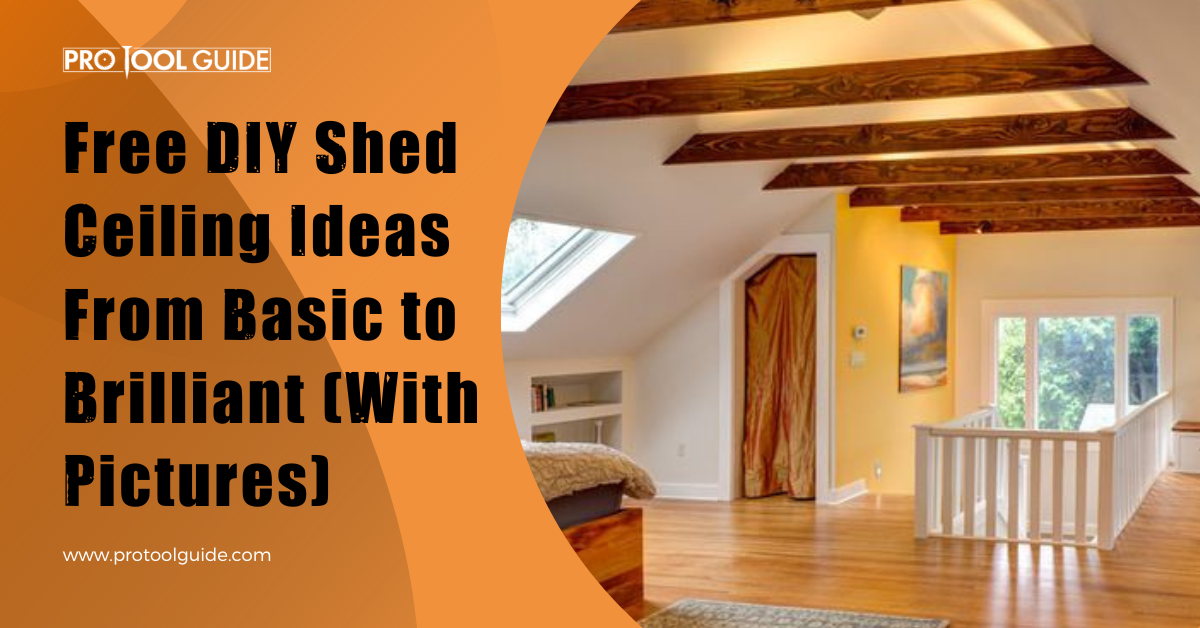Overhead protection against the weather goes beyond adding a roof over your shed; it also involves installing a ceiling between the roof and the living space below. Ceilings are useful in regulating the temperature in your shed and are also great for aesthetics. Sheds need this extra layer of protection to protect the equipment inside and make the area conducive.
If you’re building a shed, you must include appropriate fittings to ensure durability and comfort inside the area. Fixing a ceiling in the shed is among the vital additions that will transform your space from boring to an attractive storage area.
One of the most challenging problems shed builders face is the need for more diverse ceiling ideas due to the limited styles used in most sheds. However, there are many more than the handful most builders use. This is why this guide is essential, as it showcases some interesting shed ceiling designs.
If you stick around for this guide, you’ll see several shed ceiling ideas with detailed plans. These diverse ceiling designs will range from basic to sophisticated and will also attract different costs to complete.
DIY Shed Ceiling Ideas
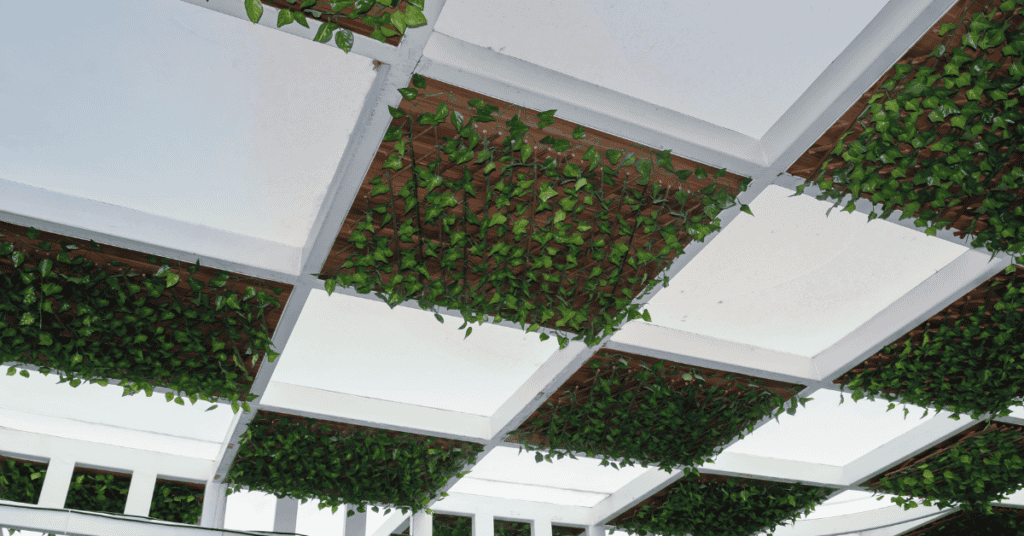
Open rafters, drywall, and wood ceilings are arguably the most common shed ceiling designs. Their popularity has led to several variations for a unique covering. Here, we’ll see some ceiling styles you can use in your shed:
1. Curved Ceiling Using Pine Picket Fence Boards

Many people avoid putting a ceiling in their shed due to the cost, but this installation can be as affordable as possible – with the right option. This design features a shed ceiling made from affordable pine picket fence boards. The position of the trusses and the installation process delivers a slight curve of wood in the ceiling for an incredible shape.
Fixing the boards perpendicular to the trusses make installation straightforward, especially for the curved end. While aesthetics is one of the inspirations for the curved part of the ceiling, the extra space between the ceiling and the roof will help with insulation.
The first video highlights the process, type of wood, and cuts to make panels and follows the builders as they install the initial layers. In the second video, the full ceiling is visible while the builder explains some of the choices and provides further information. While the design is affordable and aesthetically pleasing, the plan must be more comprehensive for a new DIYer.
2. Metal Frame And Plasterboard Ceiling

Lumber is the most popular material for shed ceilings; however, metal frames are a unique option for a strong, simple ceiling. Aside from their strength, metal framed ceilings are great as acoustic blockers. The ceiling is a combination of a metal frame and plasterboard.
Following detailed plans like the one provided in this video is always a pleasure as it makes the building process easy. The plan features all the materials and tools with their uses while highlighting their importance and subsidies you can use. The most accurate method of marking the frame area is using a level line to draw the lines around the shed walls.
The edge channels are the first pieces installed on the walls; getting an extra helping hand will prove useful. Follow the guide to see how to set up the complete frame and the plasterboard. You’ll also find the ideal distance between plasterboard screws.
3. DIY Shiplap Shed Ceiling
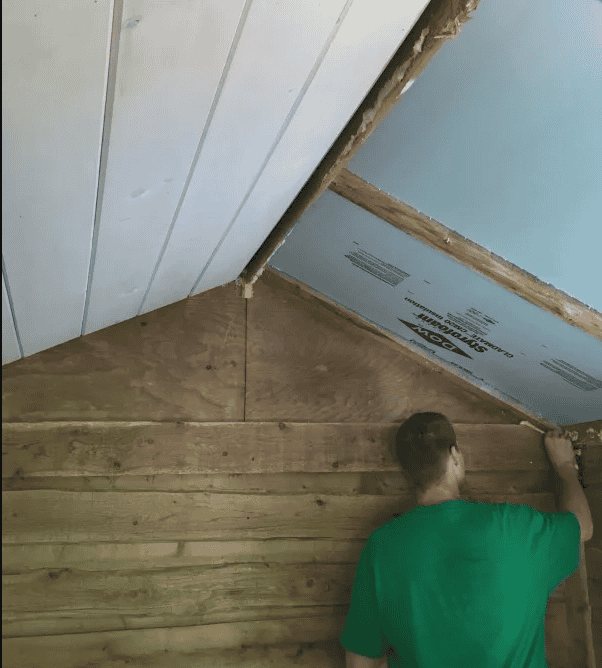
This DIY shiplap guide is similar to the tongue and groove ceiling but features wider boards, creating a simpler look. It features a faux beam parallel to the boards and at the center. The faux beam provides the platform to hang fans without damaging the ceiling.
You must select the right shiplap ceiling to buy. You can make a refined or rustic ceiling design by purchasing boards with a smooth and rough side. Priming the board on the ground before installation will make your work easier, as staining the board overhead is a backbreaking task.
You need to take your time when installing the boards for the shiplap, especially the first board. Getting the first board position right will make adding subsequent boards a breeze. Use a nail and a nail gun to secure the boards while ensuring to only nail as many as required to prevent creating too many holes.
4. Drop Ceiling
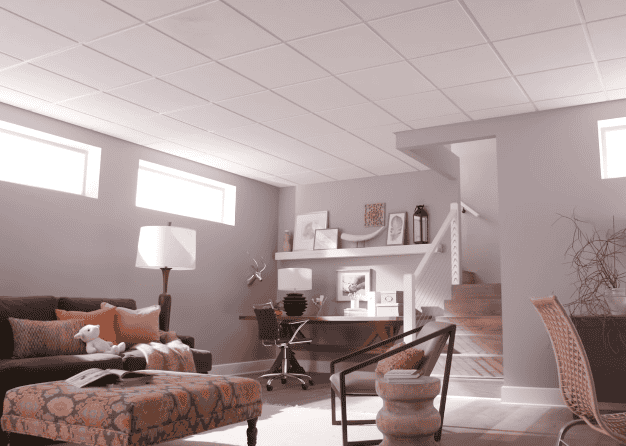
This plan provides a detailed guide to installing a suspended ceiling system. It starts with safety information and the materials you need to purchase to ensure safety. You’ll also see the tools you need, which include a hammer, measuring tape, ladder, wire cutting pliers, straight edge, and more.
Pre-building stages like site preparation and layout planning are important to ensure you choose the correct hanging direction and cut materials that fit. You’ll start building by installing wall molding while properly aligning them. Laser or spirit levels are helpful tools to get the correct wall molding position.
Hanger wire and fasteners are the traditional ways to hang a ceiling. The guide shows the exact dimension for fixing hanger wires to your roof beams so it is durable and can hold the ceiling’s weight. After building the frame and supporting them using the previously installed metal wires, you can proceed to fix the ceiling panels. The panels can break easily, so pay extra attention when handling them.
5. Exposed Beam Ceiling
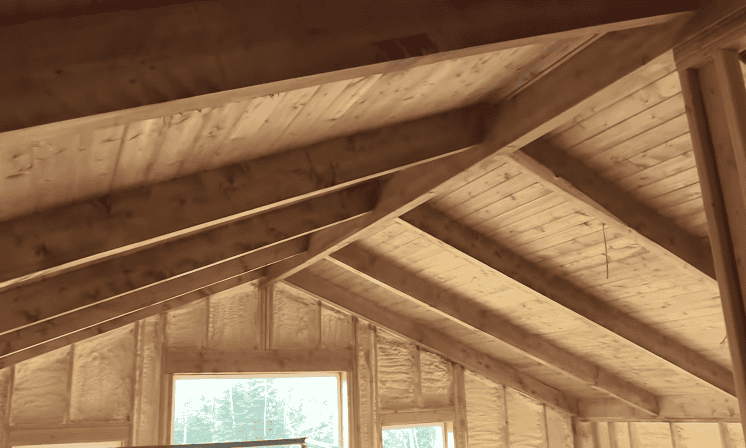
Exposed beam ceilings are especially popular in most sheds as it is easy to install when building the shed. However, it can be challenging if the shed has already been built. The roofing frame lumbers, or beams, are left exposed to create a rustic look in your shed. It also allows for more overhead room, which can mean enough space to add a shed loft.
This ceiling type is fixed atop the roof frame before the roofing sheet. A common problem with this ceiling design is the minimal space between the ceiling and the roof which may make shed insulation difficult. Ensure to pad the available space to provide a conducive environment inside the shed.
Tongue and groove boards are ideal for making exposed beam shed ceilings, with their durability supporting the roof. While the plan features the staining of the ceiling after installation, it would be considerably easier to stain the ceiling and beams before installation.
6. Plywood Ceiling
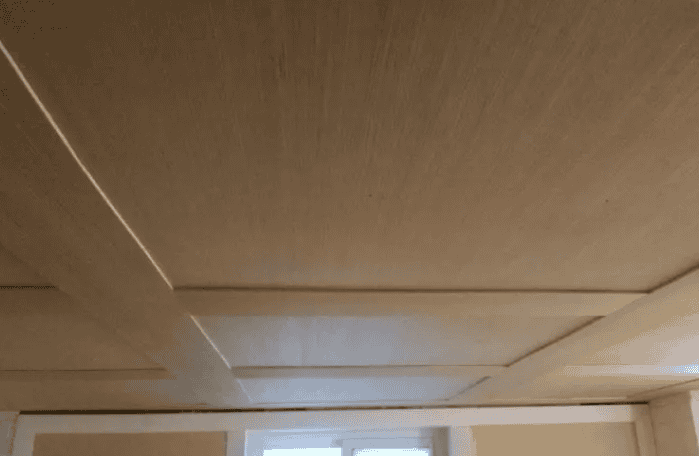
You can use plywood to make an attractive ceiling that looks like wood paneling. Here plywood boards are fixed to lumber frames with other plywood pieces used as battens on the ceiling. Besides its amazing look, it is also surprisingly affordable. This is a great choice if you’re working with a strict budget.
You’ll find a list of all the necessary materials and a five-step process for building the ceiling in the plan attached below. It starts with making a plan and ends with finishing the plywood to give it an attractive look. The finish involves filling holes, sanding, and staining the wood.
It is always best to leave filling up holes till after staining and only fill if it is obvious. Otherwise, you’re better off leaving tiny, insignificant holes alone. Also, use color-matched candle fillers instead of regular wood putty to prevent the unsightly look of different colors on the ceiling.
7. Herringbone Ceiling

Herringbone patterns are exquisite but can look intimidating, especially to new DIYers. This herringbone ceiling takes much time to cut and install the boards to make an interesting pattern. You would think such an incredible ceiling design would cost a lot to install, but it’s the opposite. Getting the materials for this ceiling is low-cost.
The plywood used for this design comes in 4’x8′ boards but is cut against the grain into 4’x2′ pieces. Evenly-spaced joists make it extremely easy to cut the planks, as all the pieces would be the same size. For unevenly spaced joists, you must measure the distance between each joist and cut accordingly.
Herringbone patterns can be confusing but become a breeze once you understand their pattern. This guide provides a detailed report on the style with formulas to make the correct cuts for each piece. Follow the link for all the information you need to complete this ceiling.
FAQ’s
This FAQ section contains helpful answers to frequent questions about shed ceiling installation:
Ans: The most affordable materials to cover your ceiling are plywood planks, beadboard, wallpaper, foam ceiling tiles, and sometimes PVC drop ceiling tiles.
Ans: Yes, shed ceiling designs can fit into your bedroom, kitchen, and study areas. However, their compatibility would depend on the type of shed ceiling you choose.
Ans: Some factors you must consider when choosing a shed ceiling are your budget, shed ceiling design compatibility with your shed, ceiling height, insulation, and many others. This will help you make the right choice of the ceiling.
Conclusion
Little additions like fixing a shed ceiling can affect your shed’s conduciveness and look. You want to pay extra attention when choosing the type of ceiling to install. You can make a more informed decision with several options available to you. Follow the detailed DIY plan that accompanies the design.

